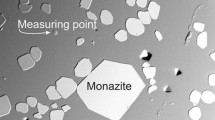Abstract
Experiments at 750 °C, 200 MPa(H2O), a (H2O)=1, and fO2∼Ni-NiO established that the equilibrium among tourmaline, biotite, cordierite, and melt (± spinel, aluminosilicate, or corundum) occurs with ∼2 wt% B2O3 in strongly peraluminous melt with an aluminosity, measured by the parameter ASI, of >1.2. The experiments demonstrate the relationship of tourmaline stability to the activity product of the tourmaline components boron and aluminum, which are inversely related to one another. Tourmaline is unstable in metaluminous to mildly peraluminous melts (ASI <1.2) at 750 °C regardless of their boron content. For a given aluminosity, addition of components such as F requires a greater boron content of melt at this equilibrium. The stability of tourmaline increases with decreasing temperatures below 750 °C. At the inception of melting, tourmaline breaks down incongruently to assemblages containing crystalline AFM silicates (biotite, cordierite, garnet, sillimanite), aluminates (spinel, corundum), and B-enriched but Fe-Mg-poor melt. Granitic melts are likely to be undersaturated in tourmaline from the start of their crystallization, and their initial boron contents will be limited by the abundance of tourmaline in their source rocks. Quartzofeldspathic (gneissic, metapelitic) rocks that reached conditions of the granulite facies and still contain (prograde) tourmaline are rare, and probably have never yielded a partial melt. Most leucogranitic magmas will initially crystallize biotite, cordierite, or garnet, but not tourmaline. With crystallization, the Fe-Mg content of melt decreases, and the B2O3 content increases until the tourmaline-biotite and/or tourmaline-cordierite (or garnet) equilibria are attained. The B2O3 content of melt is buffered as long as these equilibria continue to operate, but low initial Fe-Mg contents of the magmas limit the quantity of boron that can be consumed by these reactions to <1 wt% B2O3. Normally, leucogranitic magmas contain insufficient Fe and Mg to conserve all boron as tourmaline and thus lose a large fraction of magmatic boron to wallrocks. Leucogranites and pegmatites with tourmaline as an early and only AFM silicate mineral probably contained >2 wt% B2O3 in their bulk magmas.
Similar content being viewed by others
Author information
Authors and Affiliations
Additional information
Received: 6 August 1996 / Accepted: 21 July 1997
Rights and permissions
About this article
Cite this article
Wolf, M., London, D. Boron in granitic magmas: stability of tourmaline in equilibrium with biotite and cordierite. Contrib Mineral Petrol 130, 12–30 (1997). https://doi.org/10.1007/s004100050346
Issue Date:
DOI: https://doi.org/10.1007/s004100050346




